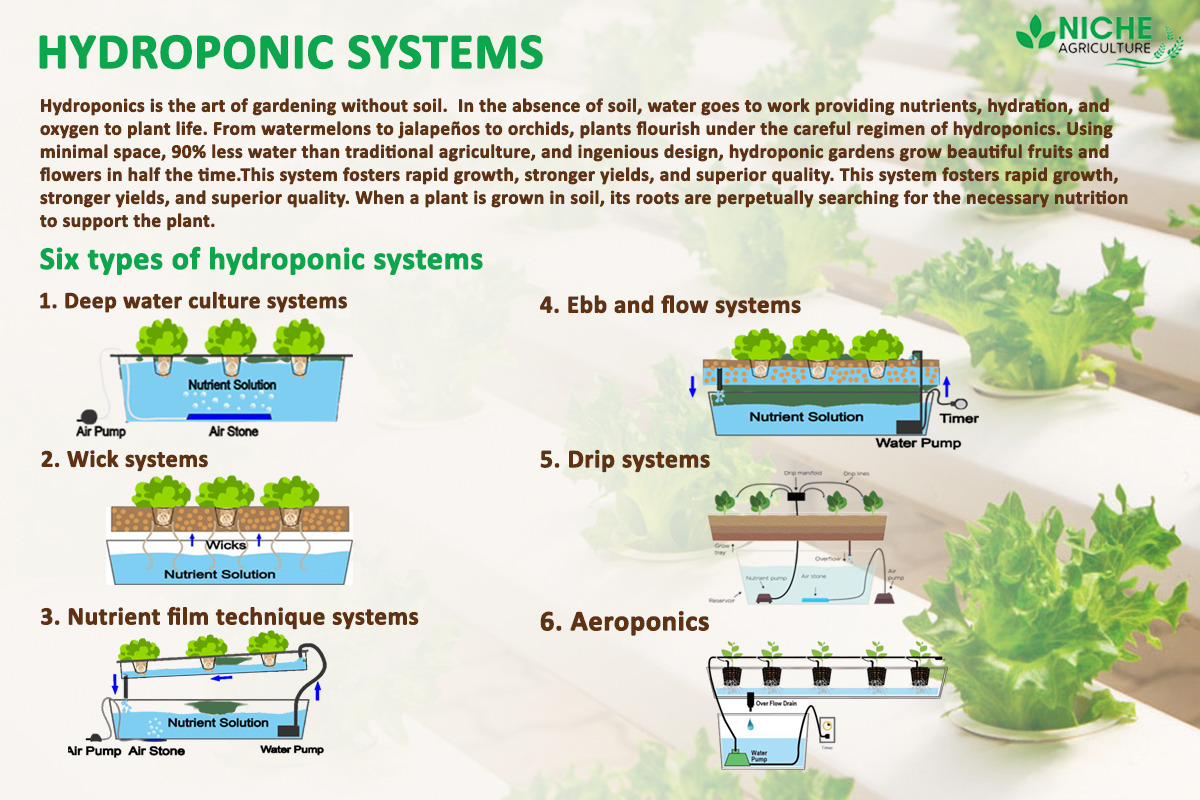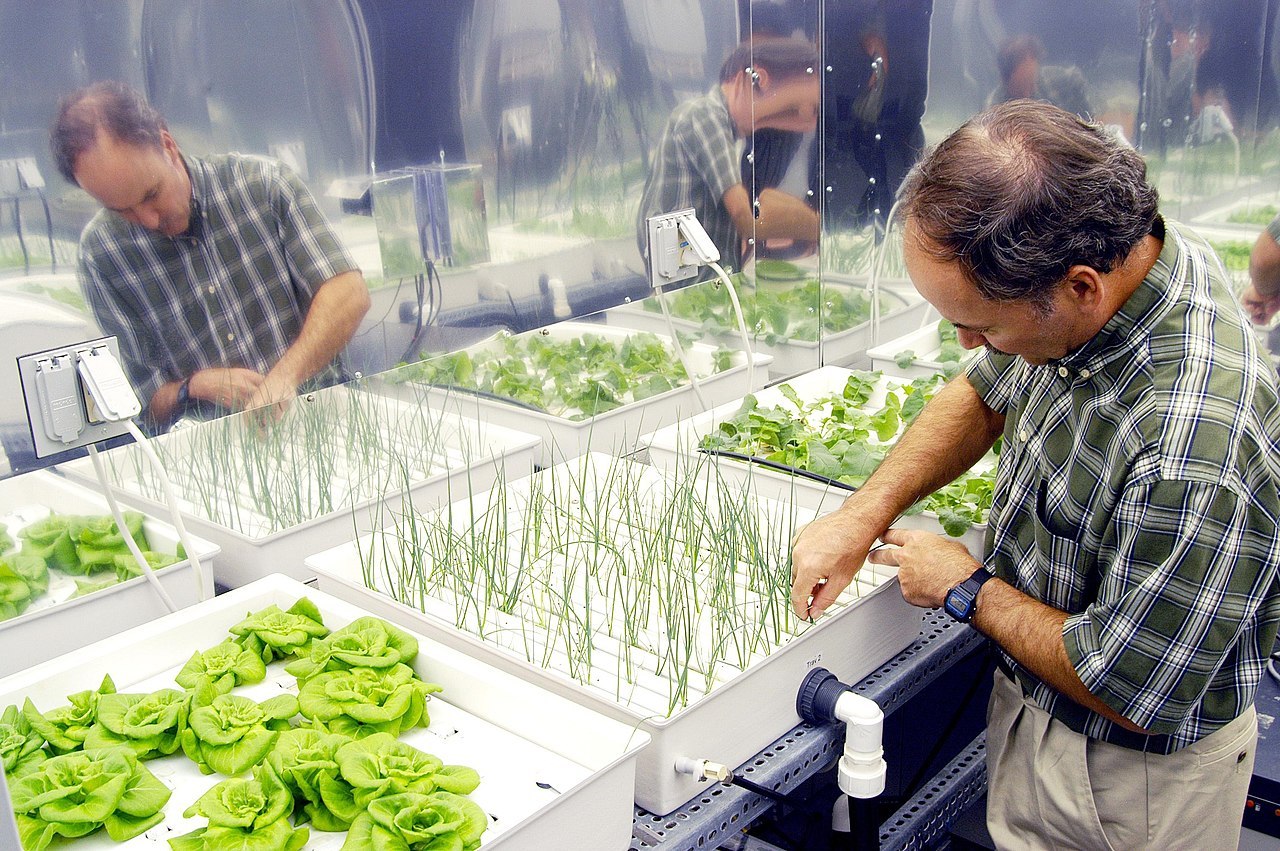
Despite inert media, roots can cause changes of the rhizosphere pH and root exudates can affect rhizosphere biology and physiological balance of the nutrient solution by secondary metabolites.[3][4][5] Transgenic plants grown hydroponically allow the release of pharmaceutical proteins as part of the root exudate into the hydroponic medium.
The nutrients used in hydroponic systems can come from many different sources, including fish excrement, duck manure, purchased chemical fertilizers, or artificial nutrient solutions.
Plants are commonly grown hydroponically in a greenhouse or contained environment on inert media, adapted to the controlled-environment agriculture (CEA) process. Plants commonly grown hydroponically include tomatoes, peppers, cucumbers, strawberries, lettuces, and cannabis, usually for commercial use, and Arabidopsis thaliana, which serves as a model organism in plant science and genetics.
Hydroponics offers many advantages, notably a decrease in water usage in agriculture. To grow 1 kilogram (2.2 lb) of tomatoes using intensive farming methods requires 214 liters (47 imp gal; 57 U.S. gal) of water using hydroponics, 70 liters (15 imp gal; 18 U.S. gal); and only 20 liters (4.4 imp gal; 5.3 U.S. gal) using aeroponics.
Hydroponic cultures lead to highest biomass and protein production compared to other growth substrates, of plants cultivated in the same environmental conditions and supplied with equal amounts of nutrients.
Since hydroponics takes much less water and nutrients to grow produce, it could be possible in the future for people in harsh environments with little accessible water to grow their own food.
Hydroponics is not only used on earth, but has also proven itself in plant production experiments in space.Around the 1930s plant nutritionists investigated diseases of certain plants, and thereby, observed symptoms related to existing soil conditions such as salinity. In this context, water culture experiments were undertaken with the hope of delivering similar symptoms under controlled laboratory conditions. This approach forced by Dennis Robert Hoagland led to innovative model systems (e.g., green algae Nitella) and standardized nutrient recipes playing an increasingly important role in modern plant physiology. In 1929, William Frederick Gericke of the University of California at Berkeley began publicly promoting that the principles of solution culture be used for agricultural crop production. He first termed this cultivation method "aquiculture" created in analogy to "agriculture" but later found that the cognate term aquaculture was already applied to culture of aquatic organisms. Gericke created a sensation by growing tomato vines twenty-five feet (7.6 metres) high in his back yard in mineral nutrient solutions rather than soil. He then introduced the term hydroponics, water culture, in 1937, proposed to him by W. A. Setchell, a phycologist with an extensive education in the classics.[1][24] Hydroponics is derived from neologism υδρωπονικά (derived from Greek ύδωρ=water and πονέω=cultivate), constructed in analogy to γεωπονικά (derived from Greek γαία=earth and πονέω=cultivate), geoponica, that which concerns agriculture, replacing, γεω-, earth, with ὑδρο-, water.
Despite initial successes, however, Gericke realized that the time was not yet ripe for the general technical application and commercial use of hydroponics for producing crops. He also wanted to make sure all aspects of hydroponic cultivation were researched and tested before making any of the specifics available to the public. Reports of Gericke's work and his claims that hydroponics would revolutionize plant agriculture prompted a huge number of requests for further information. Gericke had been denied use of the university's greenhouses for his experiments due to the administration's skepticism, and when the university tried to compel him to release his preliminary nutrient recipes developed at home, he requested greenhouse space and time to improve them using appropriate research facilities. While he was eventually provided greenhouse space, the university assigned Hoagland and Arnon to re-evaluate Gericke's claims and show his formula held no benefit over soil grown plant yields, a view held by Hoagland. Because of these irreconcilable conflicts, Gericke left his academic position in 1937 in a climate that was politically unfavorable and continued his research independently in his greenhouse. In 1940, Gericke, whose work is considered to be the basis for all forms of hydroponic growing, published the book, Complete Guide to Soilless Gardening. Therein, for the first time, he published his basic formula involving the macro- and micronutrient salts for hydroponically-grown plants.
As a result of research of Gericke's claims by order of the Director of the California Agricultural Experiment Station of the University of California, Claude Hutchison, Dennis Hoagland and Daniel Arnon wrote a classic 1938 agricultural bulletin, The Water Culture Method for Growing Plants Without Soil, one of the most important works on solution culture ever, which made the claim that hydroponic crop yields were no better than crop yields obtained with good-quality soils. Ultimately, crop yields would be limited by factors other than mineral nutrients, especially light and aeration of the medium. However, in the introduction to his standard work on hydroponics, published two years later, Gericke pointed out that the results published by Hoagland and Arnon in comparing the yields of experimental plants in sand, soil and solution cultures were based on several systemic errors ("...these experimenters have made the mistake of limiting the productive capacity of hydroponics to that of soil. Comparison can be only by growing as great a number of plants in each case as the fertility of the culture medium can support").
For example, the Hoagland and Arnon study did not adequately appreciate that hydroponics has other key benefits compared to soil culture including the fact that the roots of the plant have constant access to oxygen and that the plants have access to as much or as little water and nutrients as they need. This is important as one of the most common errors when cultivating plants is over- and underwatering; and hydroponics prevents this from occurring as large amounts of water, which may drown root systems in soil, can be made available to the plant in hydroponics, and any water not used, drained away, recirculated, or actively aerated, eliminating anoxic conditions in the root area. In soil, a grower needs to be very experienced to know exactly with how much water to feed the plant. Too much and the plant will be unable to access oxygen because air in the soil pores is displaced, which can lead to root rot; too little and the plant will undergo water stress or lose the ability to absorb nutrients, which are typically moved into the roots while dissolved, leading to nutrient deficiency symptoms such as chlorosis. Eventually, Gericke's advanced ideas led to the implementation of hydroponics into commercial agriculture while Hoagland's views and helpful support by the University prompted Hoagland and his associates to develop several new formulas for mineral nutrient solutions, universally known as Hoagland solution.
One of the earliest successes of hydroponics occurred on Wake Island, a rocky atoll in the Pacific Ocean used as a refueling stop for Pan American Airlines. Hydroponics was used there in the 1930s to grow vegetables for the passengers. Hydroponics was a necessity on Wake Island because there was no soil, and it was prohibitively expensive to airlift in fresh vegetables.
From 1943 to 1946, Daniel I. Arnon served as a major in the United States Army and used his prior expertise with plant nutrition to feed troops stationed on barren Ponape Island in the western Pacific by growing crops in gravel and nutrient-rich water because there was no arable land available.
In the 1960s, Allen Cooper of England developed the nutrient film technique. The Land Pavilion at Walt Disney World's EPCOT Center opened in 1982 and prominently features a variety of hydroponic techniques.
In recent decades, NASA has done extensive hydroponic research for its Controlled Ecological Life Support System (CELSS). Hydroponics research mimicking a Martian environment uses LED lighting to grow in a different color spectrum with much less heat. Ray Wheeler, a plant physiologist at Kennedy Space Center's Space Life Science Lab, believes that hydroponics will create advances within space travel, as a bioregenerative life support system.
As of 2017, Canada had hundreds of acres of large-scale commercial hydroponic greenhouses, producing tomatoes, peppers and cucumbers.

- Aeroponics - Main article: Aeroponics
- Continuous-flow solution culture
- Fogponics - Main article: Fogponics
- Passive sub-irrigation - Main article: Passive hydroponics
- Ebb and flow (flood and drain) sub-irrigation - Main article: Ebb and flow
- Deep water culture - Main article: Main article: Deep water culture



History of Hydroponics explained
Merits & Demerits of Hydroponics

.gif)
.gif)
.gif)

No comments:
Post a Comment